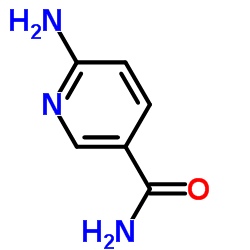6-Aminonicotinamide

6-Aminonicotinamide structure
|
Common Name | 6-Aminonicotinamide | ||
|---|---|---|---|---|
| CAS Number | 329-89-5 | Molecular Weight | 137.139 | |
| Density | 1.3±0.1 g/cm3 | Boiling Point | 381.6±27.0 °C at 760 mmHg | |
| Molecular Formula | C6H7N3O | Melting Point | 245-248 °C(lit.) | |
| MSDS | Chinese USA | Flash Point | 184.6±23.7 °C | |
| Symbol |

GHS08 |
Signal Word | Danger | |
|
A new strategy to improve the efficiency and sustainability of Candida parapsilosis catalyzing deracemization of (R,S)-1-phenyl-1,2-ethanediol under non-growing conditions: increase of NADPH availability.
J. Microbiol. Biotechnol. 19(1) , 65-71, (2009) Microbial oxidoreductive systems have been widely used in asymmetric syntheses of optically active alcohols. However, when reused in multi-batch reaction, the catalytic efficiency and sustainability of non-growing cells usually decreased because of continuous... |
|
|
Chaperone-Mediated Autophagy Targets IFNAR1 for Lysosomal Degradation in Free Fatty Acid Treated HCV Cell Culture.
PLoS ONE 10 , e0125962, (2015) Hepatic steatosis is a risk factor for both liver disease progression and an impaired response to interferon alpha (IFN-α)-based combination therapy in chronic hepatitis C virus (HCV) infection. Previously, we reported that free fatty acid (FFA)-treated HCV c... |
|
|
Nrf2 Activation Promotes Keratinocyte Survival during Early Skin Carcinogenesis via Metabolic Alterations.
Cancer Res. 75 , 4817-29, (2015) Pharmacologic activation of the transcription factor NRF2 has been suggested to offer a strategy for cancer prevention. In this study, we present evidence from murine tumorigenesis experiments suggesting there may be limitations to this possibility, based on ... |
|
|
Metabolic reconfiguration of the central glucose metabolism: a crucial strategy of Leishmania donovani for its survival during oxidative stress.
FASEB J. 29 , 2081-98, (2015) Understanding the mechanism that allows the intracellular protozoan parasite Leishmania donovani (Ld) to respond to reactive oxygen species (ROS) is of increasing therapeutic importance because of the continuing resistance toward antileishmanial drugs and for... |
|
|
Metabolomic profile of glycolysis and the pentose phosphate pathway identifies the central role of glucose-6-phosphate dehydrogenase in clear cell-renal cell carcinoma.
Oncotarget 6 , 13371-86, (2015) The analysis of cancer metabolome has shown that proliferating tumor cells require a large quantities of different nutrients in order to support their high rate of proliferation. In this study we analyzed the metabolic profile of glycolysis and the pentose ph... |
|
|
Neural stem/progenitor cells display a low requirement for oxidative metabolism independent of hypoxia inducible factor-1alpha expression.
J. Neurochem. 125(3) , 420-9, (2013) Neural stem/progenitor cells (NSPCs) are multipotent cells within the embryonic and adult brain that give rise to both neuronal and glial cell lineages. Maintenance of NSPC multipotency is promoted by low oxygen tension, although the metabolic underpinnings o... |
|
|
Multiple myeloma acquires resistance to EGFR inhibitor via induction of pentose phosphate pathway.
Sci. Rep. 5 , 9925, (2015) Multiple myeloma (MM) was characterized by frequent mutations in KRAS/NRAS/BRAF within the EGFR pathway that could induce resistance to EGFR inhibitors. We here report that EGFR inhibition solely exhibited moderate inhibition in KRAS/NRAS/BRAF wildtype (tripl... |
|
|
Glucose-6-phosphate dehydrogenase and NADPH redox regulates cardiac myocyte L-type calcium channel activity and myocardial contractile function.
PLoS ONE 7(10) , e45365, (2012) We recently demonstrated that a 17-ketosteroid, epiandrosterone, attenuates L-type Ca(2+) currents (I(Ca-L)) in cardiac myocytes and inhibits myocardial contractility. Because 17-ketosteroids are known to inhibit glucose-6-phosphate dehydrogenase (G6PD), the ... |
|
|
Synergistic activation of glucose-6-phosphate dehydrogenase and NAD(P)H oxidase by Src kinase elevates superoxide in type 2 diabetic, Zucker fa/fa, rat liver.
Free Radic. Biol. Med. 47(3) , 219-28, (2009) Glucose metabolism through the glycolysis and hexosamine pathway has been shown to be altered in type 2 diabetes. However, the fate of glucose through the pentose phosphate pathway (PPP) is currently unclear. In this study, we determined whether the activity ... |
|
|
A combination of 2-deoxy-D-glucose and 6-aminonicotinamide induces oxidative stress mediated selective radiosensitization of malignant cells via mitochondrial dysfunction.
Tumour Biol. 32 , 951-964, (2011) Oxidative stress-mediated mitochondrial dysfunction is known to induce intrinsic pathway of apoptosis. Previously, we have shown that a combination of metabolic modifiers 2-deoxy-D-glucose (2-DG) and 6-aminonicotinamide (6-AN) results in oxidative stress-medi... |